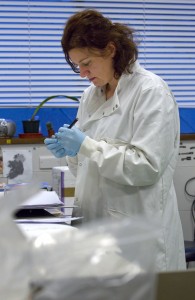The course of our Richard III nerdathon last Saturday did not run smooth, I’m afraid to say. I’ll just tear off the band-aid and state up front that the recording of the colloquium is as messed up as the live stream was. Right now, it doesn’t look like there is much of anything salvageable. St. Louis University’s Jonathan Sawday was kind enough to confirm the sad news in the comments. He apologized too, because he is a scholar and a gentleman, not because whatever went wrong was his fault.
 We shall have to feed our Richard III habit with something else, like, say, that a team led by University of Leicester geneticist Dr. Turi King will attempt to sequence the full genome of Richard III and of Michael Ibsen, his relative down the female line from Richard’s sister Anne of York. All they may have in common is in their mitochondrial DNA, but there’s always a chance they share other genetic links.
We shall have to feed our Richard III habit with something else, like, say, that a team led by University of Leicester geneticist Dr. Turi King will attempt to sequence the full genome of Richard III and of Michael Ibsen, his relative down the female line from Richard’s sister Anne of York. All they may have in common is in their mitochondrial DNA, but there’s always a chance they share other genetic links.
There’s a chance all of us share some genetic connection to Richard III, and we’ll get the chance to check it out for ourselves once the sequencing is done. Richard’s full genome will be posted online for scholars to study and the rest of us to geek way out over. He will be the first identified historical figure to have his genome sequenced.
Analysis of Richard III’s genome will allow insight into his genetic make-up, including susceptibility to certain diseases, hair and eye colour, and as the genetic basis of other diseases becomes known, these too can be examined for. It is also expected to shed light on his genetic ancestry and relationship to modern human populations. In addition, next generation sequencing technologies will allow the researchers to detect DNA from other organisms such as pathogens. Whole genome sequencing from Otzi the Iceman found the first known human infection with Lyme disease, for example.
Turi King is particularly interested in looking for DNA evidence of a predisposition to scoliosis. Since there are no surviving contemporary portraits of Richard III — the oldest were painted 40 or 50 years after his death — whatever information they can find regarding his appearance and physical traits will be an interesting confirmation or denial of the dead king’s posthumous press.
The sequencing project is being funded to the tune of £100,000 ($165,000) by the Wellcome Trust, the Leverhulme Trust and Alec Jeffreys, the genetics professor at the University of Leicester who developed genetic fingerprinting. It will done at the University of Leicester and in collaboration with Professor Michael Hofreiter at the University of Potsdam.
Although the question of where to reinter the remains has become a thorny one thanks to the legal challenge brought by the Plantagenet Alliance, a group of distant relatives of Richard’s who believe he should be buried in York rather than in Leicester, the king’s remains and all the samples taken from him will have to be buried sooner or later. Once they’re gone, there will be no going back to get a second look. Have a fully sequenced genome will provide new information well into the future. As scientists identify more genes and determine which are responsible for any given feature, researchers will be able to return to the recorded genome to find them there.
Here’s Turi King giving a brief introduction to the genome sequencing project:
[youtube=http://youtu.be/8_-crHkVgUg&w=430]
Here’s Leicester’s pitch to keep Richard’s body in the city where he was buried:
The next movement on the burial issue will be a judicial review at the High Court in London March 13th.